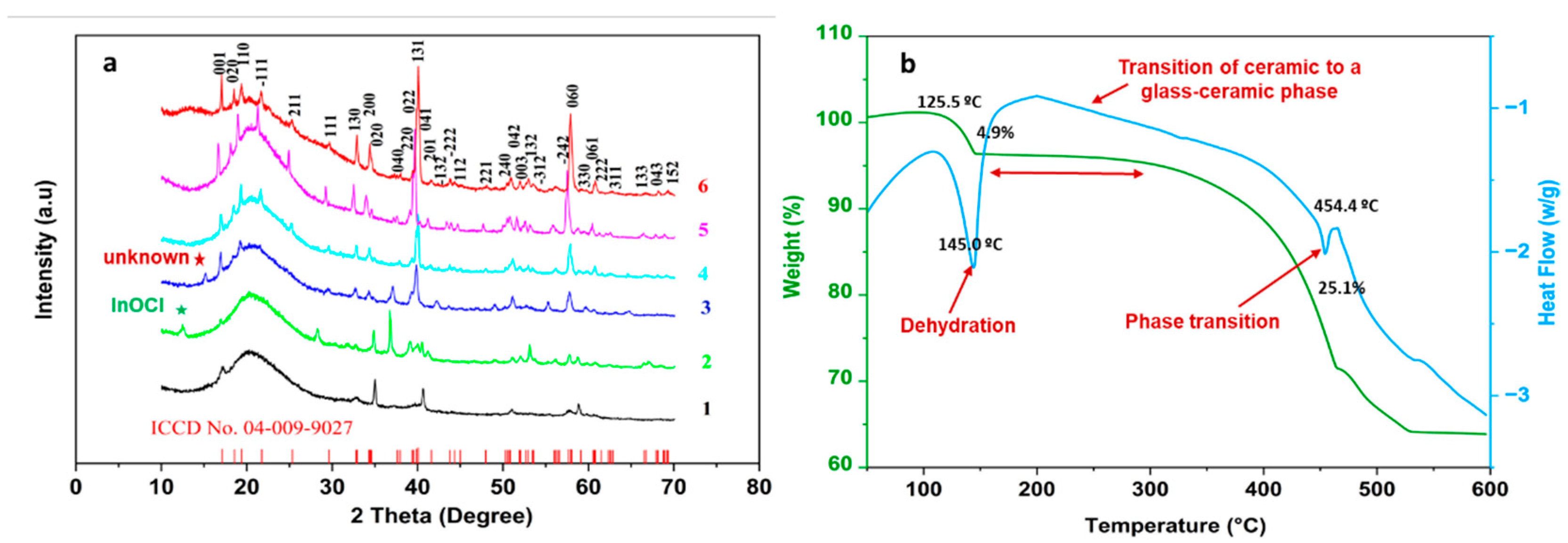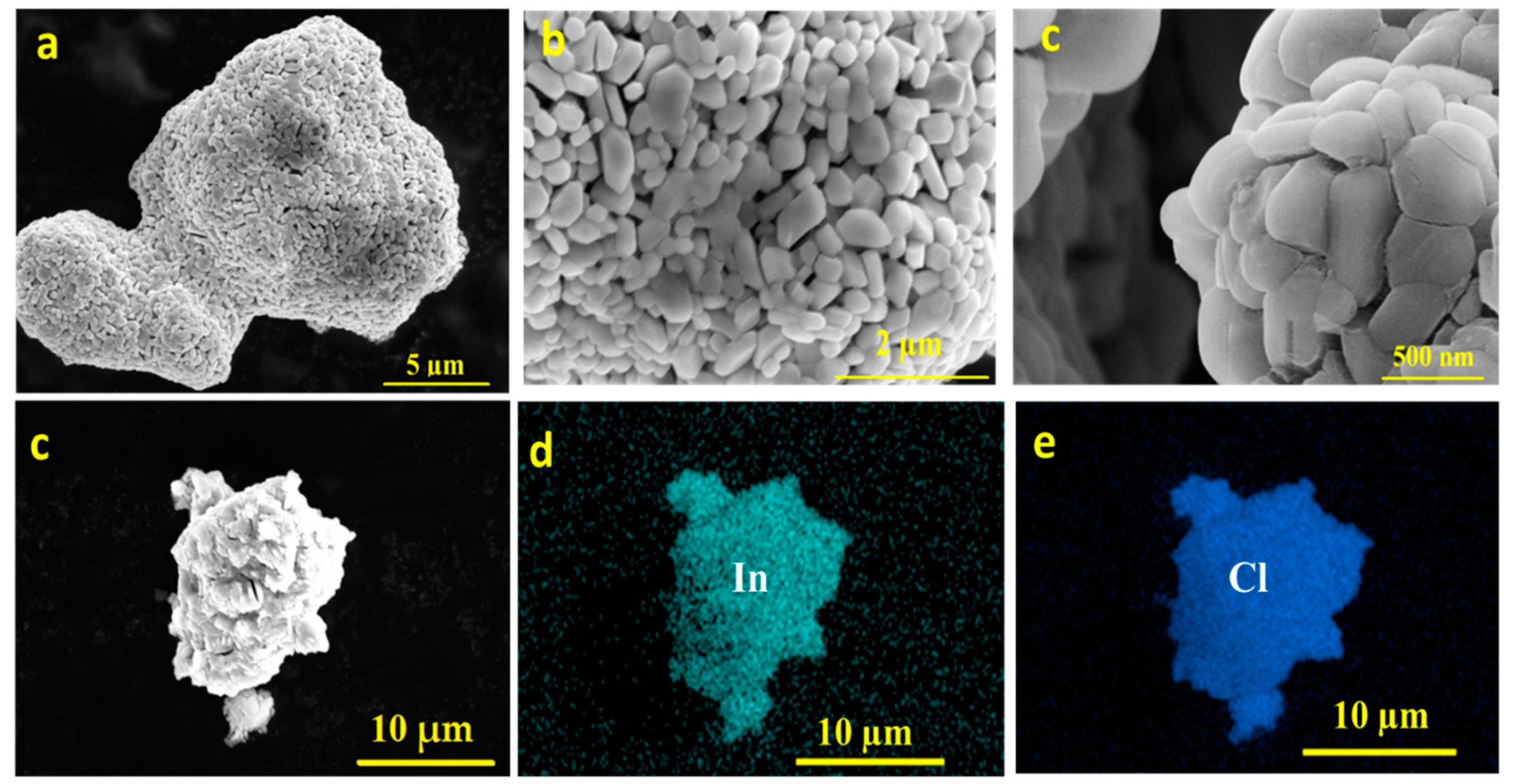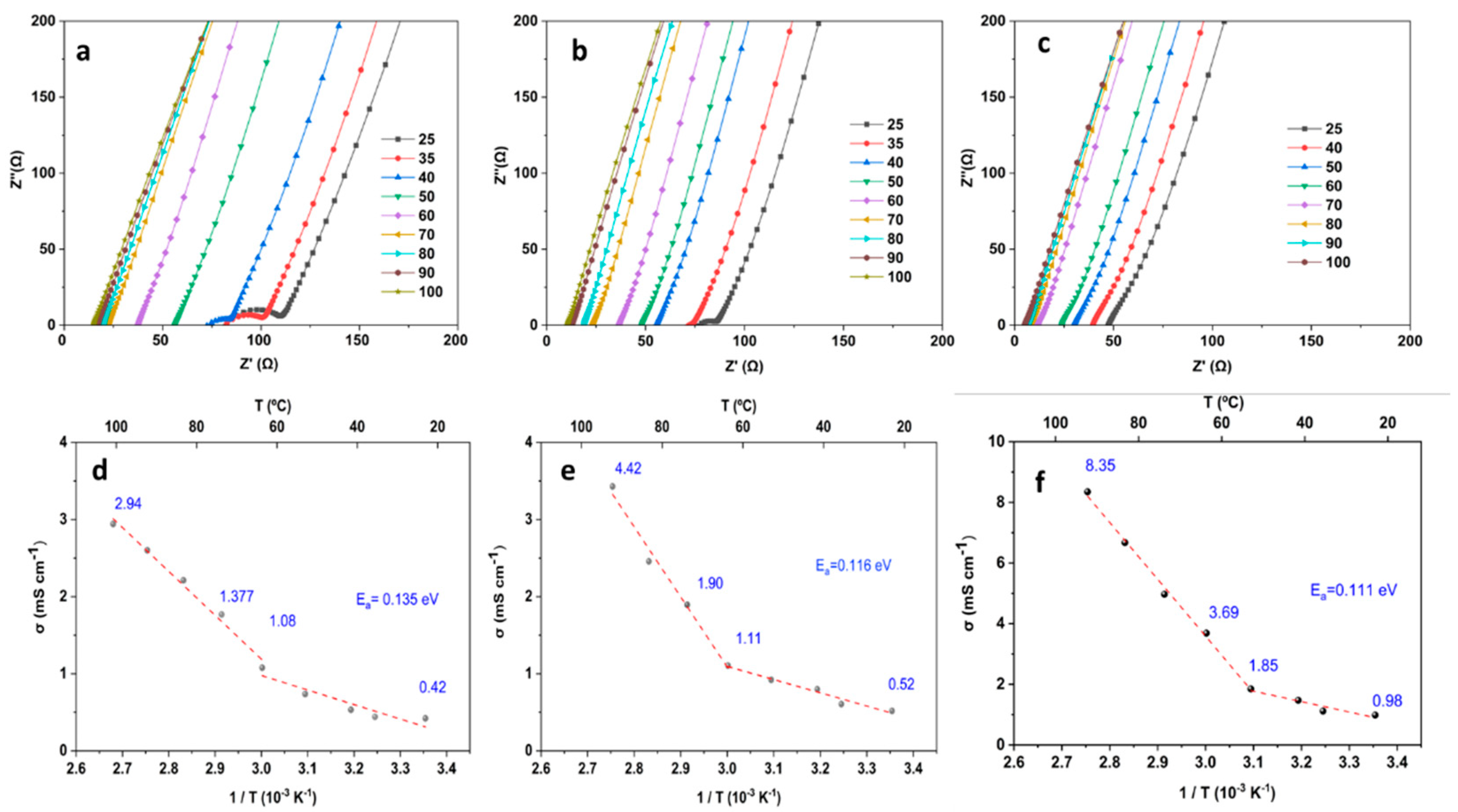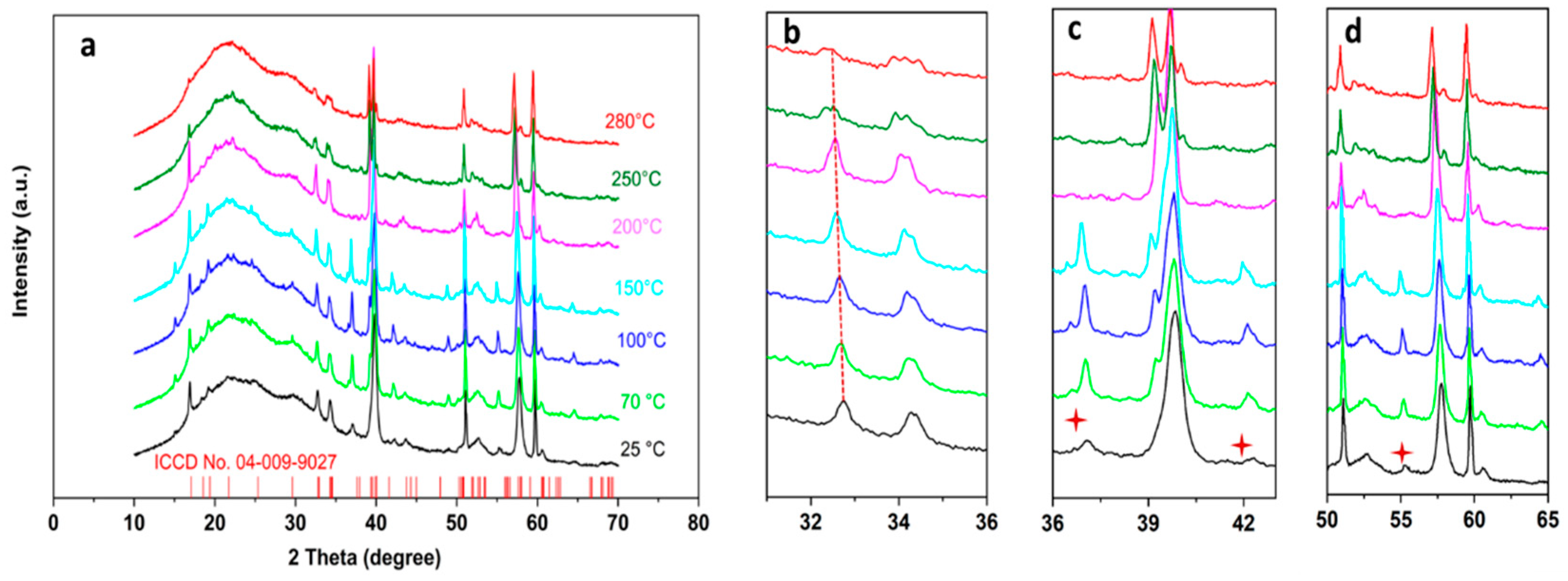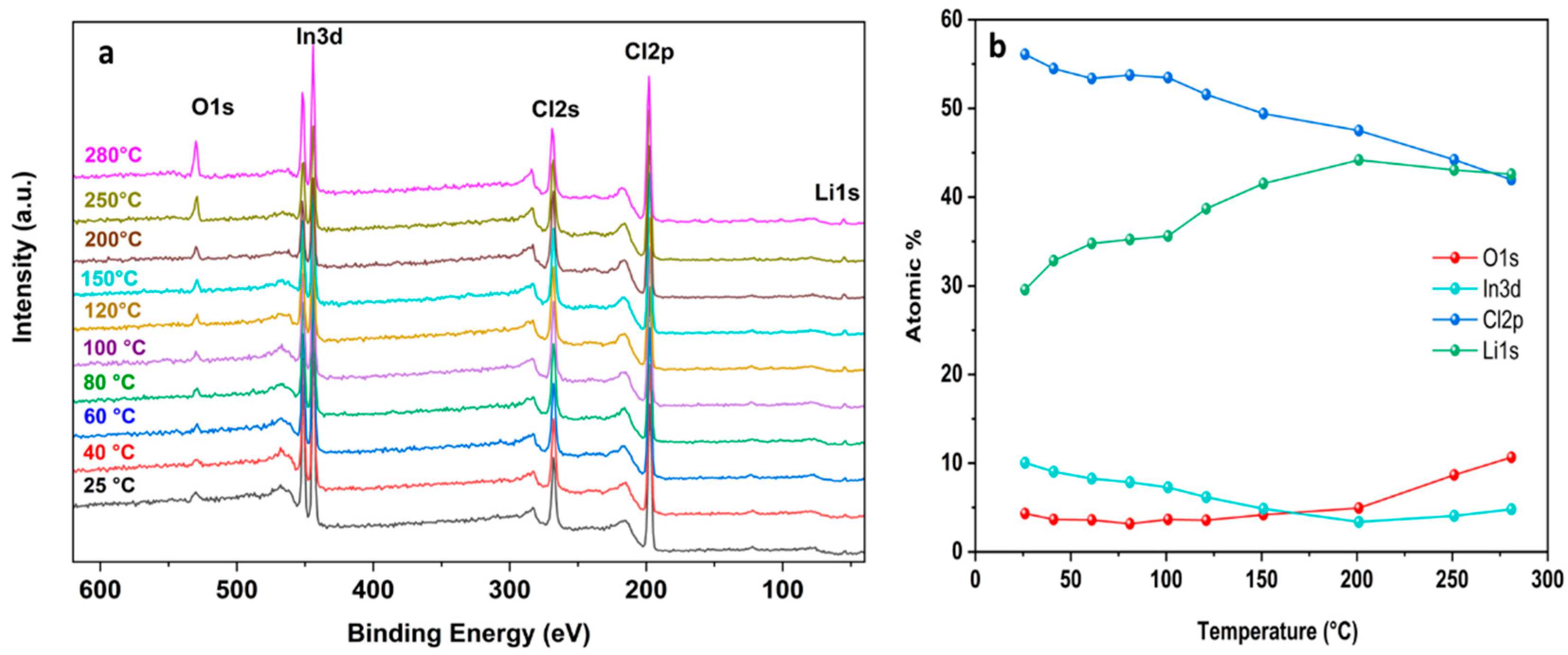1. Introduction
The increasing demand for clean energy storage systems and the swift growth of the electric vehicle industry highlighted the safety concerns associated with conventional liquid lithium-ion batteries. These batteries use flammable liquid electrolytes and are susceptible to thermal runaway [
1,
2]. In contrast, solid-state batteries (SSBs) with solid-state electrolytes (SSEs) captured significant attention for their inherent non-flammable nature and safety [
3,
4]. Additionally, SSEs enable the use of a lithium metal anode, greatly enhancing the energy density of a battery to meet the rising demand for high-performance energy storage systems [
5,
6]. However, further research is needed to address the challenges associated with their development and to ensure their widespread commercialization. An essential aspect in this pursuit is the identification of highly conductive solid-state electrolytes possessing both high lithium-ion conductivity and electrochemical stability that are crucial for safe and energy-dense SSBs [
7]. Current research in SSEs predominantly focuses on sulfide-based and oxide-based SSEs. Sulfide SSEs typically display substantial ionic conductivity (10
-3 to 10
-4 S cm
-1) at room temperature, along with good thermal stability and a broad electrochemical stability window [
8]. However, they are extremely sensitive to the atmosphere, reacting readily with water and oxygen to generate toxic H
2S gas [
9]. Furthermore, direct contact between sulfur-based SSEs and cathode results in substantial interfacial resistance due to side reactions, which are exacerbated by sulfide SSEs' decomposition at high voltages. Specifically, the oxidation of the sulfur-based Li
6PS
5Cl electrolyte at the interface with positive electrode active materials, such as LiCoO
2, LiNi
1/3Co
1/3Mn
1/3O
2, and LiMn
2O
4, leads to the formation of elemental sulfur, lithium polysulfides, P
2S
x(x≥5), phosphates, and LiCl [
10].
In contrast, oxide-based solid electrolytes are air-stable, but demonstrate high resistances at electrolyte-cathode interfaces [
11,
12,
13]. Furthermore, the oxide-based SSE synthesis involves high-temperature sintering, which causes side reactions between the electrode and oxide SSEs in the case of co-sintering [
11]. These unfavorable factors have hindered further developments in oxide SSEs. To address these challenges, researchers have made notable advancements in the development of halide-based SSEs. Lithium halide electrolytes hold great promise regarding their high ionic conductivity, thermal stability, and wide electrochemical stability window over 4.0 V [
14,
15]. Among these, Li
3InCl
6 electrolytes show good potential regarding high ionic conductivity and compatibility with high-voltage cathode materials, such as LiCoO
2 and LiNi
0.8Co
0.1Mn
0.1O
2 (NCM) [
16]. It was reported that a reversible areal capacity of 12.16 mAh cm
-2 at 0.1 mA for NMC811/Li
3InCl
6/Li
10GeP
2S
12/In at room temperature [
17] with a specific capacity of 27 mAh g
-1 at 0.1C for LiCoO
2–Li
3InCl
6/Li
3InCl
6/In cell [
15].
One of the Li
3InCl
6 -based electrolyte limitations is its sensitivity to moisture [
18] which triggers reactions leading to lower ionic conductivity. Besides moisture, the influence of operating temperature on ionic conductivity emerged as a critical factor for practical applications. However, there is an absence of detailed studies exploring the temperature effect on Li
3InCl
6 electrolytes. Our research reveals a remarkable enhancement in the ionic conductivity of Li
3InCl
6 at elevated temperatures, highlighting its potential as an SSE for advanced energy storage systems.
In this study, an efficient and flexible solid-state mechano-thermal method for the synthesis of glass-ceramic Li3InCl6, utilizing different ball-milling times and annealing temperatures is presented. Through a comprehensive investigation of the ionic conductivity of Li3InCl6 SSEs across a wide temperature range and morphology, a detailed understanding of their behavior was acquired. In-situ X-ray powder diffraction (XRD) was used to track phase changes in solid-state electrolytes (SSEs) at varying temperatures. Furthermore, X-ray Photoelectron Spectroscopy (XPS) was applied to monitor the chemical changes with temperature.
2. Materials and Methods
2.1. Synthesis of Li3InCl6 solid-state electrolyte
The Li
3InCl
6 inorganic precursors, specifically LiCl (99.98%, Aladdin), and InCl
3 (99.99%, Aladdin) with a stoichiometric ratio of 3:1 were mixed and ground using agate mortar and pestle, and then mechanically mixed for 12 or 24 hours using a high-energy ball-mill at speed 600 rpm (
Table 1). The ball-milled precursors were placed in a Schlenk tube inside the argon glovebox to prevent moisture absorption. Then the sealed tube is placed in the tubular furnace. The samples were annealed at different temperatures (260, 450, 500, or 600 °C) for 2 or 5 hours at a heating rate of 5 °C min
-1 in a vacuum, using the vacuum pump with a suction power of 2.5 ft
3 min
-1.
2.2. Materials Characterization
The morphology and structure of the samples were characterized by scanning electron microscopy (SEM) by using the Thermo Scientific Helios 5CX) equipped with an EDX analyzer. In-situ XRD analysis at different temperatures was performed by using the EMPYREAN X-ray diffractometer from Malvern PANalytical, Co Kα λ = λ = 1.78899 Å) with a hot stage. In-situ/operand X-ray photoelectron spectroscopy was acquired from Thermo Fisher Scientific using Nexsa G2 surface analysis system with a DualBeam charge compensation system for precise analysis of the Li
3InCl
6 with negligible electronic conductivity [
19].
The water absorption behavior of Li3InCl6 was evaluated by using thermogravimetric analysis (TGA) with scanning calorimetry. The samples (7.06 mg) were weighed in the argon glove box and transferred in a sealed container to the (SDT Q600 V20.9 Build 20). The measurements were performed under argon gas flow (100 mL min-1) within the temperature range of 25 to 600 °C at a 5 °C min-1 scan rate.
2.3. Electrochemical Characterization
The ionic conductivity of Li3InCl6 powder was measured by the Solartron 1260 analyzer in the frequency range from 0.3 MHz to 1.0 Hz in a temperature range of 25 to 100 °C using an environmental chamber. For each EIS measurement, 100 mg of powder was placed within a 12 mm diameter PEEK split cell from MSE supplies equipped with two stainless-steel electrodes, a pressure jig, and a load sensor.
The solid-state electrolyte disks from the optimized Li
3InCl
6 powder (
Table 1, sample 6) were produced by applying different compression forces specifically 216, 260, and 286 MPa. The ionic conductivity was determined using the following equation, σ = L/RS, where L - post-palletization thickness (cm), S- pellet area (cm
2), and R- resistance (Ω). The activation energy (E
a) was derived from the corresponding Arrhenius plots.
3. Results and discussion
3.1. Structural and thermal analysis
The X-ray diffraction (XRD) patterns of the ball-milled and annealed Li
3InCl
6 samples (
Table 1) reveal varying crystallinity based on the annealing temperatures (
Figure 1a). Without heat treatment, the sample ball-milled for 12 hr exhibits broad peaks indicating its low crystallinity. In contrast, all the samples heat-treated in the temperature range of 260-600 °C reveal sharp peaks and high crystallinity [
15]. At lower annealing temperatures (260-450 °C), the XRD spectra match the monoclinic Li
3InCl
6 crystal structure belonging to the C2/m space group (ICCD No. 04-009-9027). However, at higher temperatures (500 and 600 °C), certain characteristic peaks of Li
3InCl
6 at approximately 2θ= 21° and 25° were absent. Particularly, the XRD pattern of the Li
3InCl
6 sample annealed at 600°C revealed the presence of an impurity phase, specifically InOCl (2θ= 12.5 °) [
20]. In addition, a weak unknown peak (2θ= 15.2 °) was observed at 500 °C, which diminished as the annealing temperature decreased to 260 °C.
Furthermore, the XRD data for Li
3InCl
6 samples indicate that high-purity Li
3InCl
6 solid electrolyte can be produced with short ball-milling times (12 hr) and low annealing temperatures (260 °C). In comparison to previous reports requiring 24 hr of ball milling [
15], the sample annealed at 260 °C for 2 hr and ball-milled for 12 hr (
Table 1, Sample 6) are selected as the most promising candidate for further electrochemical studies, representing an optimized Li
3InCl
6.
An important property of many solid-state electrolytes and, specifically, indium halides is moisture sensitivity [
17]. The Li
3InCl
6 sample demonstrates moisture sensitivity, which is observed through controlled exposure to ambient air, leading to the formation of Li
3InCl
6·2H
2O [
21].
Figure 1b illustrates semi-quantitative TGA/DSC data for the optimized Li
3InCl
6. The weight loss of the Li
3InCl
6 sample at 145.0 °C is 4.91%, signifying the removal of the water molecules from the Li
3InCl
6 surface and producing the corresponding endothermic effect. The second effect in the temperature range of 145 to 280 °C reveals that the mass of the Li
3InCl
6 sample remains constant. However, the endothermic effect is observed in this temperature range that could be assigned to partial and gradual transformation from ceramic to a glass-ceramic phase and evolution of chlorine from the sample, as shown in the following XPS results (Figure 5). At 454.4 °C, the third endothermic effect is observed which could be explained by further chlorine loss and phase transition. This observation provides essential insights into the material's dynamic behavior under thermal conditions.
3.2. Morphological analysis
Material morphology is vital for shaping properties and influencing material properties. Glass-ceramic solid electrolytes, with their specific morphology, show promise for solid-state electrolytes, offering enhanced ion conductivity and mechanical durability even at high temperatures [
22].
Based on the results of the comparative study, the morphology of the most promising Li
3InCl
6 material was studied at different magnifications (
Figure 2a–c). The Li
3InCl
6 particles exhibit characteristic agglomerate morphology consisting of smaller particles of irregular shape. Their glass-ceramic nature and particle size distribution range from 200 nm to 500 nm offer greater flexibility to tolerate the volume expansion during charge-discharge processes, lower porosity after applying compression force, and better interfacial contact, for example, with cathode nanoparticles. The elemental analysis of Li
3InCl
6 nanostructures performed by EDS revealed the Li
3InCl
6 chemical composition and uniform distribution of In and Cl with the atomic ratio of In (At. %): Cl (At. %) =1: 5.9 that matches the atomic ratio of these elements in Li
3InCl
6 (
Figure 2c,d).
3.3. Electrochemical performance evaluation
The ionic conductivity of the optimized Li
3InCl
6 sample was evaluated, by investigating the impact of compression force applied to the synthesized powder and varying temperatures. The Nyquist plots (
Figure 3a–c) depict sample behavior under pressure ranging from 216 to 286 MPa and temperatures changing from 25 °C to 100°C for stainless steel blocking electrodes. The calculated ionic conductivities are represented by Arrhenius plots (
Figure 3d–f). Notably, the sample's conductivity at room temperature decreased from 105 Ω (at 216 MPa) to 45 Ω (at 286 MPa), which translated into ionic conductivities of 0.42 mS/cm and 0.98 mS/cm, respectively. This data matches the previously published results for Li
3InCl
6 synthesized from water solutions [
23].
The activation energy within the temperature range of 25-70 °C for pressures of 216, 260, and 286 MPa is 0.135, 0.116, and 0.111 eV, respectively. This fluctuation is attributed to pressure-induced modification in grain-to-grain contacts. As depicted in
Figure 3d–f, Arrhenius plots consist of two fitting lines from 25 to 60 °C and 70 to 100 °C. As the temperature increases, the slope of the Arrhenius plot becomes obviously steeper above 70 °C, indicating a higher diffusion activation energy. This result could be explained by the phase transformation of the monoclinic structure to the other crystal structure at higher temperatures leading to a significant conductivity increase at and above 70 °C. In the past, similar observations were reported, for example for chlorine-based electrolytes that demonstrated orthorhombic to tetragonal/cubic phase transformations [
24]. Another possible explanation for the observed increase in lithium-ion conductivity can be attributed to the decrease of the interfacial barrier at the solid electrolyte interface (SEI) at elevated temperatures [
24]. These assumptions were further confirmed by applying in-situ XRD and XPS analysis.
SEM images of pellet surfaces were obtained under different pressures (
Figure 4a–c). At a lower compression force of 216 MPa, the surface of the pellet is less uniform and shows more voids within the structure, yielding lower conductivity. Conversely, higher compression results in higher ionic conductivity due to increased material density and more uniform morphology, fostering increased contact between grains [
25].
3.4. In-situ-XRD and XPS analysis
In-situ XRD analysis for the optimized Li
3InCl
6 electrolyte was performed by using a controlled heating method in the temperature from 25 °C to 280 °C (
Figure 5a–d). Notably, visible changes in peaks are observed indicating a shift in the positions of the peaks at 2θ = 32.7.8°, 34.3°, 51.2°, 57.7°, and 59.6°, moving towards lower values within the temperature range of 70 °C to 280 °C. Interestingly, a new shoulder peak emerges at 2θ = 39.3°at 70 °C, indicating the formation of a new crystal structure. Moreover, the peaks at 2θ = 37.1°, 42.2°, and 55.1° exhibit higher intensities during this temperature change (
Figure 5c,d). Interestingly, as the temperature surpasses 200 °C, these peaks gradually diminish, implying an ongoing transformative process.
Though important for understanding phase transitions happening while increasing the temperature, in-situ XRD doesn’t provide information about the chemical composition. This information was obtained by using in-situ/operando XPS.
Figure 6a displays the binding energies corresponding to the constituent elements (O1s, In3d, Cl2p, Li1s) at different temperatures. Based on the chemical surface analysis of the Li
3InCl
6 powder (
Figure 6b) the atomic percentage of these elements (O, In, Cl, Li) during the heating is changing. The O1 intensity gradually decreases up to 120°C, suggesting a potential reduction in surface oxygen concentration. However, it increases post-120°C. The In3d peak consistently decreases from 25 °C to 200 °C, followed by a slight increase up to 280 °C, implying changes in indium's chemical state or bonding environment, related to alterations in its oxidation state or bonding configuration. The Cl2p intensity decreases from room temperature to 280 °C, indicating changes in the chemical state or bonding environment of chlorine. Meanwhile, the Li1s intensity increases from 25 °C to 280 °C, with a slight upturn after 200 °C. This trend suggests alterations in the chemical state or bonding environment of lithium, potentially reflecting changes in lithium-related species.
A notable increase in ionic conductivity at temperatures above 70 °C may be associated with changes in the material's structure or phase transformation. Specifically, variations in the In3d and Li1S peaks may indicate modifications in the indium and lithium bonding environment. Phase transformations often involve alterations in the arrangement of atoms and bonding configurations, impacting the material's properties. The XPS data reveals shifts or changes in intensity, particularly in Cl2p and In3d, suggesting changes in the surface chemistry and bonding environments of chlorine and indium. Such changes could influence the material's conductivity by affecting the movement of ions, contributing to enhanced ionic conductivity.
4. Conclusion
In summary, a comprehensive understanding of the ionic conductivity in the halide SSE of Li3InCl6 across a broad temperature range was revealed for the first time. This was achieved through the integration of ex-situ EIS, TGA/DSC, and in-situ characterization methods, such as in-situ X-ray and XPS analysis. Compared to other publications, the optimized material with high ionic conductivity of about 1.0 mS⋅cm-1 was synthesized at a much lower temperature (260 oC) and shorter ball-milling time, while applying a compression force of 286 MPa.
Our findings highlight the enhancement in Li3InCl6 ionic conductivity at elevated temperatures that can be ascribed to the changes in the material's composition, particularly evident in the altered chemical states and bonding environments of indium, chlorine, and lithium. After the surface-bound water is lost, the mass of Li3InCl6 remains constant up to 280 oC. However, a negative heat flow is observed that could be assigned to ceramic/ glass transformations and changes in chemical composition. In-situ XRD and XPS analyses confirm the assumptions regarding structural and chemical changes during temperature variations. The emergence of new peaks in XRD patterns and shifts in XPS binding energies indicate phase transformations and alterations in the chemical states or bonding environments of constituent elements. Notably, changes in indium and lithium bonding environments may contribute to the observed increase in ionic conductivity above 70 °C and phase transformation at 454.4 oC as confirmed by the TGA analysis. Consequently, the application of this electrolyte in industrial contexts holds both feasibility and substantial promise.
Author Contributions
Conceptualization, F.B. and A.S.; methodology, F.B.; software, F.B.; validation, F.B., and A.S.; formal analysis, F.B.; investigation, F.B., and A.S; resources, F.B. and A.S; data acquisition, F.B., C.R., P.M., and K.L.; writing—original draft preparation, F.B.; writing—review and editing, F.B. and A.S.; supervision, A.S.; project administration, F.B., and A.S; funding acquisition, A.S. All authors have read and agreed to the published version of the manuscript.
Funding
The authors acknowledge financial support from the NSF IUCRC program for supporting the ‘‘Center for Solid-state Electric Power Storage (CEPS)’’ and the South Dakota “Governor’s Research Center for Electrochemical Energy Storage’’.
Data Availability Statement
Data Availability Statement: Data available on request. The data presented in this study are available on request from the corresponding author.
Acknowledgments
The authors gratefully acknowledge the administrative and technical support from faculty and students at the South Dakota School of Mines and Technology.
Conflicts of Interest
The authors declare no conflict of interest.
References
- Wang, S.; Wu, Y.; Ma, T.; Chen, L.; Li, H.; Wu, F., Thermal stability between sulfide solid electrolytes and oxide cathode. ACS nano 2022, 16 (10), 16158-16176. [CrossRef]
- Luo, X.; Cai, D.; Wang, X.; Xia, X.; Gu, C.; Tu, J., A novel ethanol-mediated synthesis of superionic halide electrolytes for high-voltage all-solid-state lithium–metal batteries. ACS Appl. Mater. Interfaces 2022, 14 (26), 29844-29855. [CrossRef]
- Peng, J.; Wu, D.; Lu, P.; Wang, Z.; Du, Y.; Wu, Y.; Wu, Y.; Yan, W.; Wang, J.; Li, H., High-safety, wide-temperature-range, low-external-pressure and dendrite-free lithium battery with sulfide solid electrolyte. Energy Stor. Mater. 2023, 54, 430-439. [CrossRef]
- Asano, T.; Sakai, A.; Ouchi, S.; Sakaida, M.; Miyazaki, A.; Hasegawa, S., Solid halide electrolytes with high lithium-ion conductivity for application in 4 V class bulk-type all-solid-state batteries. Adv. Mater. 2018, 30 (44), 1803075. [CrossRef]
- Chen, R.; Li, Q.; Yu, X.; Chen, L.; Li, H., Approaching practically accessible solid-state batteries: stability issues related to solid electrolytes and interfaces. Chem. Rev. 2019, 120 (14), 6820-6877. [CrossRef]
- Trahey, L.; Brushett, F. R.; Balsara, N. P.; Ceder, G.; Cheng, L.; Chiang, Y.-M.; Hahn, N. T.; Ingram, B. J.; Minteer, S. D.; Moore, J. S., Energy storage emerging: A perspective from the Joint Center for Energy Storage Research. Proc. Natl. Acad. Sci. 2020, 117 (23), 12550-12557. [CrossRef]
- Famprikis, T.; Canepa, P.; Dawson, J. A.; Islam, M. S.; Masquelier, C., Fundamentals of inorganic solid-state electrolytes for batteries. Nat. Mater.2019, 18 (12), 1278-1291. [CrossRef]
- Zhu, Y.; Mo, Y., Materials design principles for air-stable lithium/sodium solid electrolytes. Angew. Chem., Int. Ed. 2020, 59 (40), 17472-17476. [CrossRef]
- Xu, R.; Wang, X.; Zhang, S.; Xia, Y.; Xia, X.; Wu, J.; Tu, J., Rational coating of Li7P3S11 solid electrolyte on MoS2 electrode for all-solid-state lithium-ion batteries. J. Power Sources. 2018, 374, 107-112. [CrossRef]
- Auvergniot, J.; Cassel, A.; Ledeuil, J.-B.; Viallet, V.; Seznec, V.; Dedryvère, R., Interface stability of argyrodite Li6PS5Cl toward LiCoO2, LiNi1/3Co1/3Mn1/3O2, and LiMn2O4 in bulk all-solid-state batteries. Chem. Mater. 2017, 29 (9), 3883-3890. [CrossRef]
- Wang, D.; Sun, Q.; Luo, J.; Liang, J.; Sun, Y.; Li, R.; Adair, K.; Zhang, L.; Yang, R.; Lu, S., Mitigating the interfacial degradation in cathodes for high-performance oxide-based solid-state lithium batteries. ACS Appl. Mater. Interfaces 2019, 11 (5), 4954-4961. [CrossRef]
- Lu, P.; Liu, L.; Wang, S.; Xu, J.; Peng, J.; Yan, W.; Wang, Q.; Li, H.; Chen, L.; Wu, F., Superior all-solid-state batteries enabled by a gas-phase-synthesized sulfide electrolyte with ultrahigh moisture stability and ionic conductivity. Adv. Mater. 2021, 33 (32), 2100921. [CrossRef]
- Thangadurai, V.; Narayanan, S.; Pinzaru, D., Garnet-type solid-state fast Li-ion conductors for Li batteries: critical review. Chem. Soc. Rev. 2014, 43 (13), 4714-4727. [CrossRef]
- Sakuma, M.; Suzuki, K.; Hirayama, M.; Kanno, R., Reactions at the electrode/electrolyte interface of all-solid-state lithium batteries incorporating Li–M (M= Sn, Si) alloy electrodes and sulfide-based solid electrolytes. Solid State Ion. 2016, 285, 101-105. [CrossRef]
- Li, X.; Liang, J.; Luo, J.; Banis, M. N.; Wang, C.; Li, W.; Deng, S.; Yu, C.; Zhao, F.; Hu, Y., Air-stable Li 3 InCl 6 electrolyte.
- with high voltage compatibility for all-solid-state batteries. Energy Environ. Sci. 2019, 12 (9), 2665-2671. [CrossRef]
- Zhou, L.; Zuo, T.-T.; Kwok, C. Y.; Kim, S. Y.; Assoud, A.; Zhang, Q.; Janek, J.; Nazar, L. F., High areal capacity, long cycle life 4 V ceramic all-solid-state Li-ion batteries enabled by chloride solid electrolytes. Nat. Energy 2022, 7 (1), 83-93. [CrossRef]
- Li, X.; Liang, J.; Chen, N.; Luo, J.; Adair, K. R.; Wang, C.; Banis, M. N.; Sham, T. K.; Zhang, L.; Zhao, S., Water-mediated synthesis of a superionic halide solid electrolyte. Angew. Chem 2019, 131 (46), 16579-16584. [CrossRef]
- Li, W.; Liang, J.; Li, M.; Adair, K. R.; Li, X.; Hu, Y.; Xiao, Q.; Feng, R.; Li, R.; Zhang, L., Unraveling the origin of moisture stability of halide solid-state electrolytes by in situ and operando synchrotron X-ray analytical techniques. Chem. Mater. 2020, 32 (16), 7019-7027. [CrossRef]
- Deng, S.; Jiang, M.; Chen, N.; Li, W.; Zheng, M.; Chen, W.; Li, R.; Huang, H.; Wang, J.; Singh, C. V., Regulating Electronic Conductivity at Cathode Interface for Low-Temperature Halide-Based All-Solid-State Batteries. Adv. Funct. Mater. 2022, 32 (45), 2205594. [CrossRef]
- Wang, K.; Ye, Q.; Zhang, J.; Huang, H.; Gan, Y.; He, X.; Zhang, W., Halide electrolyte Li3InCl6-based all-solid-state lithium batteries with slurry-coated LiNi0. 8Co0. 1Mn0. 1O2 composite cathode: effect of binders. Front. Mater 2021, 8, 727617. [CrossRef]
- Wang, S.; Xu, X.; Cui, C.; Zeng, C.; Liang, J.; Fu, J.; Zhang, R.; Zhai, T.; Li, H., Air sensitivity and degradation evolution of halide solid-state electrolytes upon exposure. Adv. Funct. Mater. 2022, 32 (7), 2108805. [CrossRef]
- Gandi, S.; Chidambara Swamy Vaddadi, V. S.; Sripada Panda, S. S.; Goona, N. K.; Parne, S. R.; Lakavat, M.; Bhaumik, A., Recent progress in the development of glass and glass-ceramic cathode/solid electrolyte materials for next-generation high capacity all-solid-state sodium-ion batteries: A review. J. Power Sources 2022, 521, 230930. [CrossRef]
- Sacci, R. L.; Bennett, T. H.; Drews, A. R.; Anandan, V.; Kirkham, M. J.; Daemen, L. L.; Nanda, J., Phase evolution during lithium–indium halide superionic conductor dehydration. J. Mater. Chem. A 2021, 9 (2), 990-996. [CrossRef]
- Song, A. Y.; Xiao, Y.; Turcheniuk, K.; Upadhya, P.; Ramanujapuram, A.; Benson, J.; Magasinski, A.; Olguin, M.; Meda, L.; Borodin, O., Protons enhance conductivities in lithium halide hydroxide/lithium oxyhalide solid electrolytes by forming rotating hydroxy groups. Adv. Energy Mater 2018, 8 (3), 1700971. [CrossRef]
- Molaiyan, P.; Mailhiot, S. E.; Voges, K.; Kantola, A. M.; Hu, T.; Michalowski, P.; Kwade, A.; Telkki, V.-V.; Lassi, U., Investigation of the structure and ionic conductivity of a Li3InCl6 modified by dry room annealing for solid-state Li-ion battery applications. Mater. Des. 2023, 227, 111690. [CrossRef]
|
Disclaimer/Publisher’s Note: The statements, opinions and data contained in all publications are solely those of the individual author(s) and contributor(s) and not of MDPI and/or the editor(s). MDPI and/or the editor(s) disclaim responsibility for any injury to people or property resulting from any ideas, methods, instructions or products referred to in the content. |
© 2023 by the authors. Licensee MDPI, Basel, Switzerland. This article is an open access article distributed under the terms and conditions of the Creative Commons Attribution (CC BY) license (http://creativecommons.org/licenses/by/4.0/).
